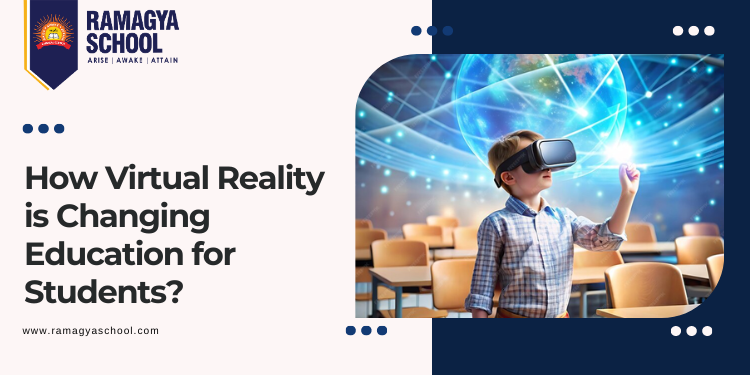Virtual reality and augmented reality are two modern technologies that have revolutionized the field of education. By engaging the client in virtual content or combining the digital world with the real world, virtual reality in education and augmented reality can further develop learning. We’ll take a look at the benefits of augmented reality (AR) in education and how virtual reality is changing guidance.
Understanding Augmented Reality (AR)
An innovation known as “augmented reality” combines computer-generated data or visuals with the real world. AR and virtual reality (VR), which submerge you in a sophisticated environment, are not quite the same. AR merely incorporates digital elements into the world as it exists now.
Imagine using smart glasses or your smartphone to project helpful information on your surroundings. For example, you may use your phone to point at a landmark to view its experiences, or try on virtual clothes before purchasing them.
Exploring Virtual Reality (VR)
An invention called virtual reality in education (VR) allows you to feel as though you are somewhere else even though you are still in the same area. VR displays a world created by a PC to you while you wear amazing eyewear. You’re going to play a user-friendly video game on your PC.
You can interact with articles and navigate this virtual environment just like you would in real life. VR transports you to locations such as the deepest ocean or the outermost layer of Mars. It’s finished with a lot of great stuff, including getting space travelers ready, looking into old wrecks, and playing around.
Learning becomes easier and more enjoyable using VR. Prepare for an experience unlike any other by donning your virtual reality headset.
Advantages of Augmented Reality in Education:
- Real-World Applications: This program allows students to manipulate and visualize virtual objects within real-world settings, which fosters practical understanding.
- AR Develops Inspiration: The intuitive components of AR spark students’ interest and motivate them to actively participate in cases.
- Applications: AR apps can be tailored to each student’s preferred learning style, enabling them to provide a unique vision.
- AR Improves Retention Rates: AR reinforces concepts through visual and tactile learning, which increases retention rates.
- Accessibility: AR allows students to learn remotely and from a distance.
- Skills Development: This program promotes critical reasoning, problem solving, and collaborative skills through interactive tasks.
Advantages of Virtual Reality in Education:
- Immersive learning: VR creates realistic environments that immerse students in different time periods, places and scenarios.
- Experiential learning: This type of learning allows students to learn by doing in simulated situations. They can practice their skills and procedures without risk.
- Student Engagement: VR engages students and keeps them focused by providing interactive, visually stimulating content.
- Global Collaboration: VR allows for global collaboration and cultural interchange by connecting students around the globe in shared virtual spaces.
- Remote areas: Students can now access remote locations virtually.
- Empathy: VR can help foster empathy by allowing students to experience perspectives that are different from theirs.
- Career Readiness: VR Simulations provide hands-on training for students to prepare them for real-world career opportunities in areas such as aviation, healthcare, and engineering.
Difference between AR and VR:
| Aspect | Augmented Reality (AR) | Virtual Reality (VR) |
| Definition | Integrates digital content into the real world environment. | Creates a fully immersive, computer-generated environment. |
| Hardware | Requires devices with built-in cameras (e.g., smartphones). | Requires specialized headsets and controllers. |
| Interactivity | Overlays virtual elements onto the physical world. | Completely replaces the physical environment with a virtual one. |
| Use Cases | Enhancing textbooks, interactive exhibits, and simulations. | Simulations, virtual field trips, and immersive experiences. |
| Learning Environment | Blends digital content with real-world surroundings. | Creates a simulated environment detached from the real world. |
| Immersiveness | Partial immersion, where virtual elements coexist with reality. | Full immersion, where users are completely immersed in a virtual world. |
| Application Complexity | Generally simpler to implement and use. | Often requires more sophisticated hardware and software. |
AR and VR are different in that AR is a way to enhance real-life experiences while VR allows for complete immersion into virtual environments. Both technologies have their own strengths and applications for education.
Implementing AR and VR in the Classroom
Teachers need to be ready, invest in creativity, and plan carefully in order to integrate AR and VR in the study hall. Teachers can use AR and VR tools, platforms, and apps to create programmatic experiences, work with cooperative exercises, and promote intuitive examples.
Teachers can use AR and VR to enhance their instruction, engage their students, and create dynamic environments that foster creativity, inquiry, disclosure, and progress. There are many advantages of virtual reality in education and of augmented reality as well.
Future Directions and Challenges
AR and VR have great potential for education. However, there are many challenges that need to be overcome. These include access to technology, costs, and barriers to implementation. It’s important that educators, policymakers and technology developers collaborate to address these challenges as these technologies continue their evolution and become more available. We can use AR and VR together to empower students and transform education.
Conclusion
AR and VR revolutionize schooling through vivid, interactive and customized experiences. These advancements give exciting ways of engaging students, upgrade learning and further develop commitment. AR and VR are turning out to be more common in classrooms. Teachers should use these advances to establish creative and dynamic learning conditions for students that will set them up for progress in the digital era.





